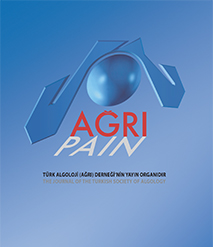Floroskopi rehberliğinde transforaminal epidural steroid enjeksiyonu ve dorsal kök gangliyon pulse radyofrekans uygulamalarının radyasyon dozlarının karşılaştırılması
Günay Er, rekib saçaklıdır, FIRAT ULUTATAR, Tülay ŞahinAlgoloji Kliniği, Seyrantepe Hamidiye Etfal Eğitim Ve Araştırma Hastanesi, İstanbul, TürkiyeAmaç
Gelecek girişimlerde radyasyon dozunu azaltmaya yönelik planların oluşturulmasına yardımcı olmak amacıyla floroskopi rehberliğinde transforaminal epidural steroid enjeksiyon (TFESI) ve dorsal kök gangliyon pulsed radyofrekans (DRG RF) uygulamasının işlem süresi ve radyasyon dozunun bulunması amaçlanmıştır
Materyal ve Metot
Bir eğitim ve araştırma hastanesinde bel ağrısı nedeniyle TFESI ve DRG RF uygulanan 696 hastanın dahil edildiği gözlemsel çalışmada her bir girişim için işlem süreleri ve radyasyon dozları kaydedilmiştir
Sonuçlar
Hastaların 189’una DRG RF ve 507’sine TFESI uygulanmıştır, toplamda 1069 girişim kaydedilmiştir. İşlem süresi ve radyasyon dozları sırasıyla 25.68 sn (7-94) ve 4.99 mGy (0.66-49.4) olarak bulunmuştur. DRG RF ve TFESI grupları arasında tanı, yaş, cinsiyet, vücut kitle indeksi, işlem seviyesi ve radyasyon dozu açısından farklılık bulunmamıştır. DRG RF grubunda işlem süresi anlamlı olarak daha kısa bulundu
Özet
TFESI ve DRG RF arasında radyasyon dozu açısından anlamlı fark olmasa da işlem süresi DRG RF grubunda daha kısa bulundu. Pulse radyofrekans maliyet göz önüne alınarak gerekli hastalarda tercih edilebilir olabilir.
Comparison of Radiation Doses of Fluoroscopy-Guided Transforaminal Epidural Steroid Injections and Dorsal Root Ganglia Pulsed-Radiofrequency Applications
Günay Er, rekib saçaklıdır, FIRAT ULUTATAR, Tülay ŞahinDepartment Of Algology, Seyrantepe Hamidiye Etfal Education And Research Hospital,ıstanbul, TurkeyObjective
The study aims to find out procedure times and estimate the radiation doses for fluoroscopy-guided transforaminal epidural steroid injection (TFESI) and dorsal root ganglion pulsed radiofrequency (DRG RF) per intervention to postulate radiation doses for potential utilization for plans to reduce radiation doses in future interventions.
Material and Methods
An observational study was conducted on six-hundred ninety-six patients patients with low back pain who underwent fluoroscopy-guided TFESI or DRG RF at an algology clinic of an training and research hospital. Procedure time and radiation dose per procedure were recorded.
Results
One hundred eighty-nine of the patients underwent DRG RF and 507 of them underwent TFESI. A total of 1069 procedures were performed. Procedure time and radiation dose per procedure were found to be 25.68 seconds (7-94) and 4.99 mGy (0.66-49.4), respectively. There was no difference between DRGRF and TFESI groups in terms of diagnosis, age, gender, BMI, procedure level, and radiation dose. It was found that the procedure time was significantly lower in the DRG group.
Conclusions
Although no difference was detected between TFESI and DRG RF in terms of radiation dose, the procedure time was found to be significantly shorter in the DRG RF group, and pulsed radiofrequency may be preferred in necessary patients, considering the cost.
Makale Dili: İngilizce





